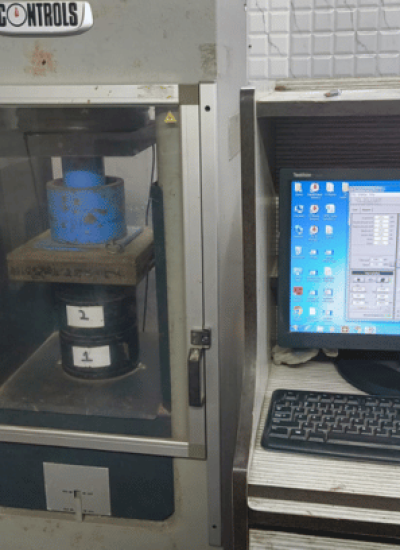Aggregates Testing
Aggregates Testing
Aggregates Testing
- Sieve Analysis
- Material finer than 75 micron
- % Silt content by weight/volume
- Specific Gravity
- Water Absorption
- Bulk Density
Services Offered
- Sieve Analysis
- Material finer than 75 micron
- % Silt content by weight/volume
- Specific Gravity
- Water Absorption
- Bulk Density

A sieve analysis (or gradation test) is a practice or procedure used (commonly used in civil engineering) to assess the particle size distribution (also called gradation) of a granular material.
The size distribution is often of critical importance to the way the material performs in use. A sieve analysis can be performed on any type of non-organic or organic granular materials including sands, crushed rock, clays, granite, feldspars, coal, soil, a wide range of manufactured powders, grain and seeds, down to a minimum size depending on the exact method. Being such a simple technique of particle sizing, it is probably the most common.
This method of test deals with the procedure for determining the total quantity of material finer than 7Smicron IS Sieve in aggregates by washing.
NOTE – Clay particles that are dispersed by wash water as well as water soluble materials will be removed from the aggregate during the test.
Ultrasonic Pulse Velocity Testing.
Silt is granular material of a size somewhere between sand and clay whose mineral origin is quartz and feldspar. Silt may occur as a soll or as suspended sediment (also known as suspended load) in a surface water body. It may also exist as soil deposited at the bottom of a water body.
1. Purpose:
The 250 ml capacity glass-measuring cylinder is used for determination of silt and clay content in sand on volume basis.
2. Procedure:
- Fill the glass-measuring cylinder with sample of sand upto 100 ml mark.
- Add clean water upto 150 ml and shake the contentswell.
- Allow contents to settle for 15 to 20 min.
- Clay and silt will be seen as a separate layer over sand.
- Measure the total height of material (A).
- Measure the height of sand layer (B).
- Find out height of silt and clay layer (A-B).
- Calculate the percentage of silt and clay in the total sand layer.
- Calculation : Silt & Clay %, (A-B) /B* 100
The fine aggregate specific gravity test is used to calculate the specific gravity of a fine aggregate sample by determining the ratio of the weight of a given volume of aggregate to the weight of an equal volume of water. It is similar in nature to the coarse aggregate specific gravity test.
Water Absorption is the percent of water necessary to add to the aggregate to obtain saturated surface dry (SSD) condition.
Limits: The Specific gravity of aggregates ranges from 2.5 to 3.0
The Water absorption ofaggregates ranges from 0.1 to 2.0%
When dealing with aggregates it is important to know the voids that presents between the aggregate particles, so that we decide whether to fill them with finer aggregate orwith cement paste.
We all know that the Density we often deal with equals the mass divided by the volume, when using this law to measure the density of aggregates the volume we use is the volume of aggregate + the volume of the voids, and in this case we get a new quantity called the Bulk Density.
Bulk Density = Mass of the aggregate \ Volume of aggregate particles with voids between them.
This bulk density is used to convert quantities by mass to quantities by volume.
Bulk density depends on several factors: Size distribution of aggregates, Shape of particles and degree of compaction.
There are two methods this quantity is measured by:
1- Loose method.
2-Compaction method.
The Principal mechanical properties required are
(i) Satisfactory resistance to crushing under the roller during construction and
(ii) adequate resistance to surface abrasion under traffic.
Aggregates used in road construction should be strong enough to resist crushing under traffic wheel loads. If the aggregates are weak, the stability of the pavement structure is likely to be adversely affected. The strength of coarse aggregates is assessed by aggregates crushing test. The aggregate crushing value provides a relative measure of resistance to crushing under a gradually applied compressive load. To achieve a high quality of pavement, aggregate possessing low aggregate crushing value should be preferred.
Toughness is the property of a material to resist impact. Due to traffic loads, the road stones are subjected to the pounding action or impact and there is possibility of stones breaking into smaller pieces. The road stones should therefore be tough enough to resist fracture under impact. A test designed to evaluate the toughness of stones i.e., the resistance of the fracture under repeated impacts may be called an impact test for road stones.
The aggregate impact value of coarse aggregate provides a relative measure of the resistance ofan aggregate to sudden shock or impact. The oven dried and accurately weighed aggregates are subjected toa total of 15 blows of specified weight and fall and percentage of fines formed in terms of the total weight of the sample is expressed as the aggregate impact value.
Limits:< 10% exceptionally strong, 10-20% Strong, 20-30% Satisfactory for road surfacing & > 35%Weak for road surfacing.
Due to the movements of traffic, the road stones used in the surfacing course are subjected to wearing action at the top. Resistance to wear or hardness is hence an essential property for road aggregates, especially when used in wearing course. Thus road stones should be hard enough to resist the abrasion due to the traffic. When fast moving traffic fitted with pneumatic tyres move on the road, the soil particles present between the wheel and road surface causes abrasion on the road stone. Steel tyres of animal drawn vehicles which rub against the stones can cause considerable abrasion of the stones on the road surface. Hence in order to test the suitability of road stones to resist the abrading action due to traffic, tests are carried out in the laboratory.
Abrasion test on aggregates are generally carried out by anyone of the following methods:
(j) Los Angeles abrasion test
(ij) Deval abrasion test
(iii) Dorry abrasion test
Of these tests, the Los Angeles abrasion test is more commonly adopted as the test values of aggregates have been correlated with performance of studies. The ISI has suggested that wherever possible, Los Angeles abrasion test should be preferred.
The principle of Los Angeles abrasion test is to find the percentage wear due to the relative rubbing action between the aggregates and steel balls used as abrasive charge; pounding action of these balls also exists while conducting the test. Some investigators believe this test to be more dependable as rubbing and pounding action simulate the field conditions where both abrasion and impact occur. Los angles abrasion test has been standardised by the ASTM, AASHO and also by the IS]. Standard specification of Los Angeles abrasion values are also available for various types of pavement constructions.
The flakiness index ofan aggregate is the percentage by weight ofparticles in it whose least dimension( thickness ) is less than three-fifths of their mean dimension. The test is not applicable to sizes smaller than 6.3 mm
The flakiness index is the total weight of the material passing the various thickness gauges or sieves, expressed as a percentage ofthe total weight of the sample gauged.
The elongation index of an aggregate is the percentage by weight of particles whose greatest dimension ( length) is greater than one and four-fifths times their mean dimension.
Normally, the properties of interest to the engineer are sufficiently covered by the flakiness or angularity tests. The elongation test is not applicable to sizes smaller than 6.3 mm.
This method of test covers the procedure for determining the ‘ten percent fines’ value of coarse aggregates.
The ‘ten percent fines’ value gives a measure of the resistance of an aggregate to crushing, that is, applicable to all aggregates.
This method of test lays down the procedure for determining the angularity number of coarse aggregate.
NOTE 1 – Angularity or absence of rounding of the particles of an aggregate is 8 property which is of importance because it affects the ease ofhandling of n mixture ofaggregate and binder, for example the workability of concrete, or the stability of mixtures that rely on the interlocking of. the particles. It is emphasised that this is e laboratory method intended for comparing the properties of different aggregates for mix ,design purposes.
NOTE 2– Since considerably more effort is used then in the test for bulk density end voids [ see IS : 2336( Part III )-1963 1, the results of the two tests are different. Also weaker aggregates may be crushed during compaction, end the angularity number test does not apply to anyaggregate which breaks down during the test.
Other Services
Bitumen Testing
Cement Testing
Steel Testing
Water Testing
Best experience with testing of construction material and chemicals. Very cooperative, understanding and efficient employees
Jerrin Jose
Best Material Testing Laboratory in Navi Mumbai!
SKG Project & Engg. Pvt. Ltd., have a state of art Material Testing Laboratory in Mumbai.
